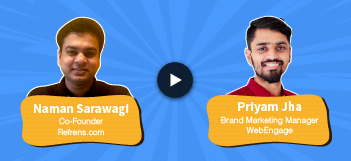About This Episode
Avinash Ambati is the Product & Growth Head at Rehlat – a leading online travel brand in the GCC region. During his previous stints, he worked as an Analytics Product Manager at Nuance Communications and Co-founder at Skafos Systems Pvt. Ltd.
Avinash’s responsibilities at Rehlat include working on Trip module planning, User retention and engagement, Data warehousing and handling the complete P&L of flight, hotel and cab bookings.
In this episode…
Avinash walks us through the critical factors in driving growth and revenue through a mobile application in the OTA industry and shares:
i. How Rehlat incorporates consumer behaviour in its mobile marketing strategy?
ii. How to do more and offer better experiences to consumers with less data?
iii. Rehlat’s CLTV prediction model and its user retention strategy.
iv. The benefit of having loyalty programs.
v. Channeling the product planning process between cross-functional teams.
Here are our top 3 picks from the episode:
1. The role of data segregation and customer journeys in reducing churn
Ashana: While speaking with Devam from Alshaya, one of the leading e-commerce players in the UAE, we came to know that the people from middle-eastern countries are a bit hesitant while sharing their personal data online as compared to the Indian consumers, who are a lot more open while giving out their data. How are you solving this problem?
Avinash: Yeah, right! So one major concern is localizing and customizing the entire booking system. Clearly, the middle-eastern market is not completely ready to share their data. Initially, we also faced this challenge but when a customer is coming to our platform, they are seeking a service for sure but they don’t want to give their data in the first stage itself. What we have gleaned from this is that they are 5-6 years behind the Indian market. We try to gather the data in a smarter way by first offering them to explore the services on the platform and then while booking, we ask them for their personal information. We don’t ask them to sign-up on Rehlat’s platform right away. That’s one way to do it! We also gather data through various customer journeys which we obtain through the SDKs such as Google Analytics, Facebook, etc. It gives us the demographics of the users such as age on an aggregate level. This data becomes useful in our daily communication strategy with the end-users.
Ashana: Great insight, Avinash!
2. The know-how of launching a feature without asking for more from the consumers
Ashana: Rehlat has a feature called price-lock through which users can lock their flight prices well before in advance. What were the insights gleaned while launching this feature?
Avinash: What we observed from the data which we collected from the users is that there are a lot of dropoffs when the user sees the final pricing of the flights. Flight booking is a 5-step process where the users discover the flight prices in the second step. We have also observed that the major bookings happen with a lead time of less than one week from the actual date of travel. We tried to understand the correlation between the number of dropoffs and the lead time. The larger the lead time, the larger the dropoffs, this is what we understood. We managed to deduce that the people are sure about their tentative travel date but they are not completely sure about their travel altogether. So we came up with the price-lock feature which enables the user to freeze the price of their booking amount at a nominal fee. This way, they end up doing the booking anyhow within the said time. We have released this feature in February 2019 and since then, we have seen a significant jump of 2-3% in overall bookings.
3. Reactivating the dormant users through minimal communication channels
Ashana: How do you re-activate the dormant users? The users who are idle and not performing any activities on the application. Do you have any existing plans for them?
Avinash: What we do is basically as I mentioned, we collect a lot of data that is on an aggregate level and on an individual level. Dormant users can be of two types. One is, for example, in the mobile app perspective. They retain the application but never open it and a few others who may have completely uninstalled the app. So again various tools give us a fair idea that what exactly was the user trying to do or was it a crash or for example whether a user is unable to complete a goal or an objective. What exactly led that user to become a dormant user and then churn? We can’t do push notifications or in-app or nothing of that sort so we are only left with communication channels like email and the second set is that we try to retarget them is using different tools. So even while retargeting them, we try to create segments again, try to understand different types of users and generally, we try to get the feedback from the users as well although the conversion from that kind of emails is low still, we get 1% or 0.5% of responses.
Closing notes
During this conversation with Avinash, we got a fair understanding of the product planning procedures at Rehlat, how Rehlat focuses on addressing the data concerns, the method to gain a clear insight into the customer’s life cycle and the importance of testing a new feature before launch.















